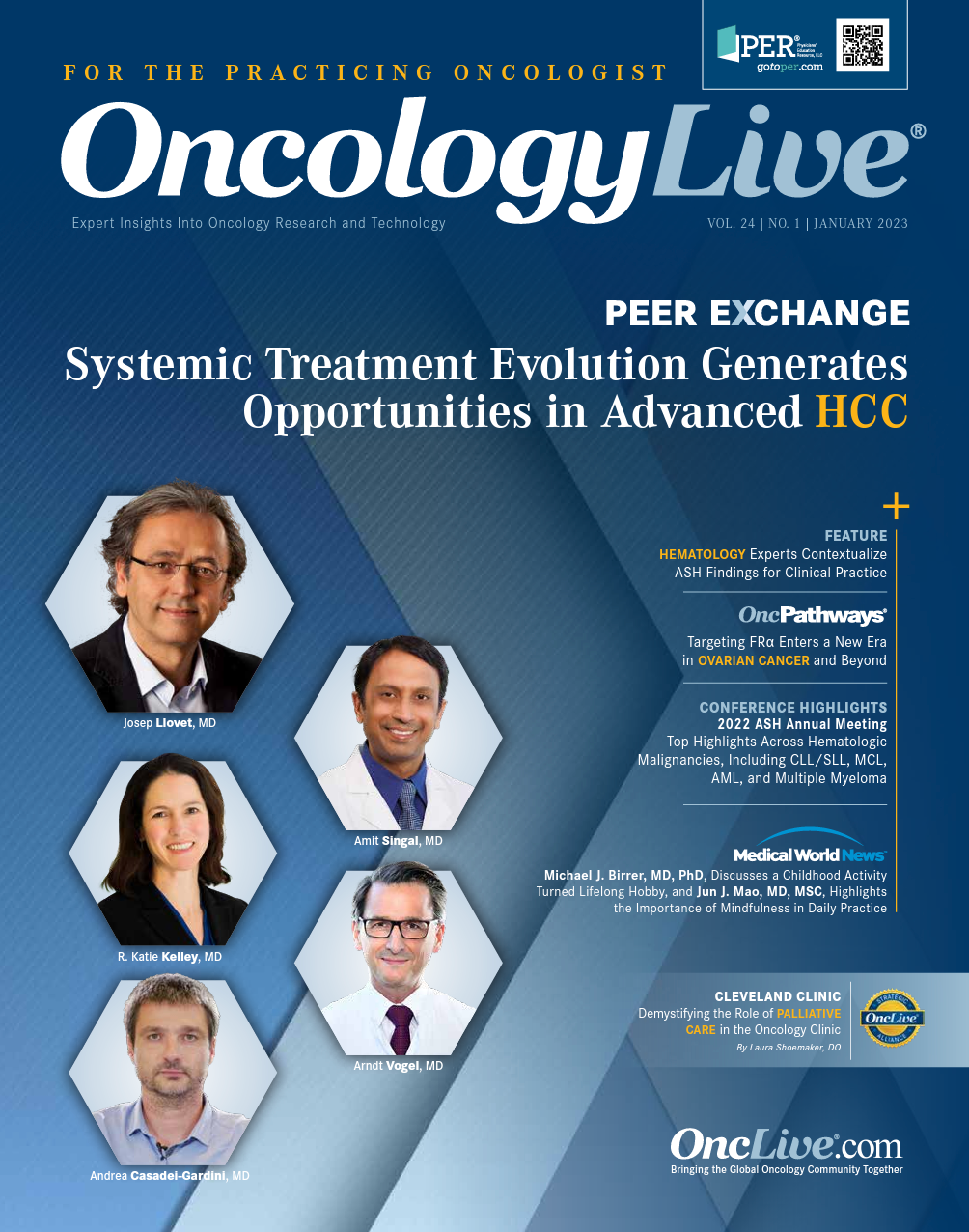Publication
Article
The Potential Clinical Utility of Cross-Trial Comparisons: An Example From Gynecologic Cancer Literature
Author(s):
because of the differences between the characteristics of research subjects and individuals routinely cared for outside the confines of a clinical trial, appropriately designed examinations of “real-world” populations may provide a more relevant picture of the actual influence of a particular therapeutic intervention.
Maurie Markman, MD

In recent years, prospective and retrospective analyses of nonrandomized population-based data have generated considerable interest among cancer investigators, third-party payers, regulatory agencies, and experts in health policy, adding to the value of phase 3 clinical trial data.
Successful efforts to critically analyze the unique contribution of a specific component of care through the conduct of a randomized trial mandates the relative homogeneity of the patient populations being compared, except for the approach being examined in the trial’s experimental arm. Therefore, such trials routinely exclude patients with common, clinically relevant but potentially confounding comorbidities (eg, history of mild or moderately serious cardiac, renal, or hepatic abnormalities) from study entry. The concern here is that in the presence of other medical conditions, it may be more difficult to clearly evaluate the specific impact of the investigative approach on objective measures of efficacy, such as survival or toxicity. However, because of the well-recognized differences between the characteristics of research subjects and individuals routinely cared for outside the confines of a clinical trial, appropriately designed examinations of “real-world” populations may provide a more relevant picture of the actual influence of a particular therapeutic intervention.
Although there has recently been considerable attention paid to differences between the randomized trial and real-world views of cancer therapeutics, another potentially interesting approach to explore would be comparisons of outcomes of separate randomized trials that examined very similar or even identical research questions. It is relevant to acknowledge here one of the classic admonitions to clinical investigators that such cross-trial comparisons should either not be undertaken or performed with great caution, because it is appropriately recognized that the randomized populations in the individual studies may be quite different from each other, despite the trial-defined eligibility criteria.
But that is precisely the point being highlighted here. In fact, if the studies are essentially identical in design but reach different clinical conclusions, what does this observation tell us about the very nature of the trial process and our interpretation of the findings of an individual research study? For example, consider the results of 2 well-designed, regulatory agency–quality, anticancer pharmacological agent clinical trials that served, at the time they were reported, as critical elements in the establishment of the standard of care in the primary chemotherapeutic management of epithelial ovarian cancer.1,2
The studies to be discussed below specifically examined the role of paclitaxel as a component of initial antineoplasticdrug therapy in this malignancy and followed the striking demonstration of meaningful clinical activity of this agent in platinum-resistant disease.3 The first compared a standard-of-care regimen (cisplatin plus cyclophosphamide) with an experimental combination of cisplatin plus paclitaxel infused over 24 hours.1 This landmark trial revealed that the paclitaxel-containing regimen improved overall survival (OS) compared with cisplatin plus cyclophosphamide. These data supported the regimen becoming standard-of-care practice to use primary cytotoxic strategy of a platinum agent plus a taxane.4 The study noted above finished accrual quickly, and its survival outcome results were unknown at that time. As a result, in the absence of such critical data, a decision was made to initiate an additional study conducted by the same group of investigators from the Gynecologic Oncology Group, with essentially the identical eligibility and ineligibility criteria. This second study examined a slightly different clinical question, with the randomly assigned patient populations receiving either single-agent cisplatin, single-agent paclitaxel, or the identical combination regimen as employed in the initial trial of cisplatin plus paclitaxel.
There are several provocative issues that can be discussed related to the differences in the outcomes of these 2 trials, including the impact of crossover from treatment with 1 of the 2 single agents to the alternative antineoplastic, but the specific point of this commentary is to highlight the rather striking difference in OS between the patient populations who received the identical combination chemotherapy regimen of cisplatin plus paclitaxel in the 2 landmark studies.1,2
In the initial trial, the median OS in the paclitaxel-containing combination regimen was 38 months. In the second trial, which was conducted quickly following completion of accrual on the first study, treatment with this identical regimen employed in a study conducted by the same group of clinicians/clinical investi-gators with essentially the same entry criteria (eligibility and ineligibility), the median OS was 26.3 months—a survival difference of almost 1 year.
Is there an explanation for this surprising and clinically difficult-to-ignore decrease in median OS associated with the receipt of the platinum/taxane combination regimen? Again, it is critical to acknowledge the fact these were separate trials with patients randomly assigned at different times, despite the fact the trials were identical in design and the clinical care of the 2 populations was provided by the same group of oncologists.
It is possible to provide a specific hypothesis as to a major reason for the differences in OS between the 2 studies. When the initial primary ovarian cancer paclitaxel trial was initiated, there was considerable appropriate concern for the potential serious cardiac effects of this agent, with sudden deaths being reported in early trials. In fact, the earliest patients entered into this randomized study required active cardiac monitoring when the 24-hour paclitaxel infusion was initiated. However, by the time the study was complete, this concern was substantially decreased as a result of the observed toxicity profile and evidence that the preciously noted serous events were most likely the result of hypersensitivity reactions rather than direct cardiac effects of the agent.
It is reasonable to speculate that because of the earlier concern the population in the initial study (either as a result of patient choice or physician recommendation) had an overall lower cardiovascular risk background compared to the research subjects in the second study. Further, selection of patients to the second study occurred at a time where there was a reduced concern for the severity of potential adverse cardiac toxicity. And the somewhat inferior median OS in the second study may have been at least partially related to the relative increased presence of individuals with this and related comorbidities (eg, diabetes, mild renal dysfunction, cerebrovascular disease, etc.) not uncommon in the population of women who develop ovarian cancer.
Finally, this now classic experience should serve as a highly relevant example of the hazards of attempting to directly compare the survival outcomes of different groups of patients in the absence of appropriate trial-based randomization.
References
- McGuire WP, Hoskins WJ, Brady MF, et al. Cyclophosphamide and cisplatin compared with paclitaxel and cisplatin in patients with stage III and stage IV ovarian cancer. N Engl J Med. 1996;334(1):1-6. doi:10.1056/NEJM199601043340101
- Muggia FM, Braly PS, Brady MF, et al. Phase III randomized study of cisplatin versus paclitaxel versus cisplatin and paclitaxel in patients with suboptimal stage III or IV ovarian cancer: a Gynecologic Oncology Group study. J Clin Oncol. 2000;18(1):106-115. doi:10.1200/JCO.2000.18.1.106
- McGuire WP, Rowinsky EK, Rosenshein NB, et al. Taxol: a unique antineoplastic agent with significant activity in advanced ovarian epithelial neoplasms. Ann Intern Med. 1989;111(4):273-279. doi:10.7326/0003-4819-111-4-273
- Armstrong DK, Alvarez RD, Backes FJ, et al. NCCN Guidelines Insights: ovarian cancer, version 3.2022. J Natl Compr Canc Netw. 2022;20(9):972-980. doi:10.6004/jnccn.2022.0047










